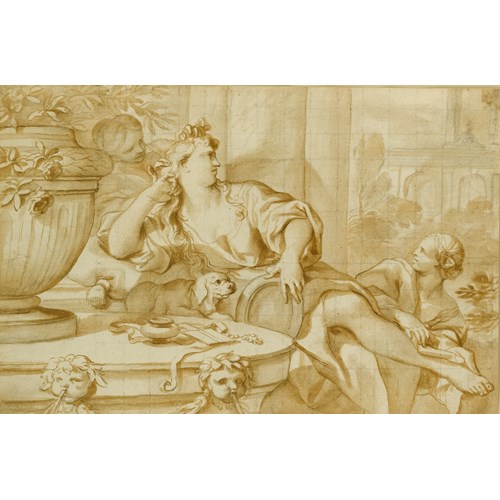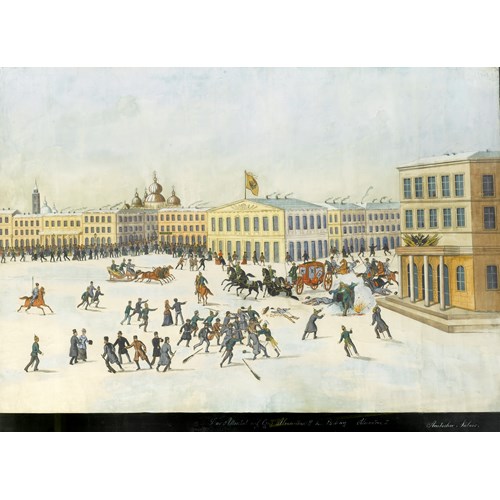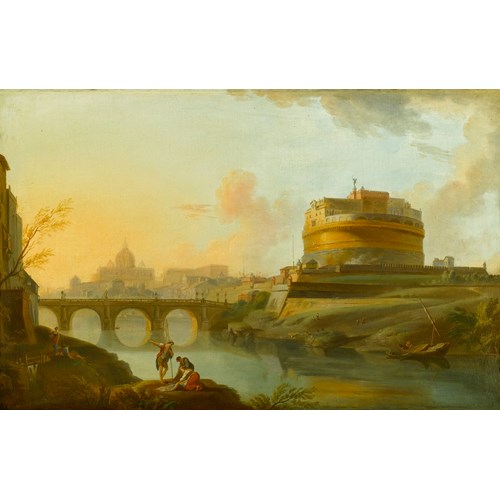Marketplace
The Grand Duke Constantine’s Regiment of Cuirassiers of the Imperial Russian Army in 1806
Johann Georg Paul Fischer
The Grand Duke Constantine’s Regiment of Cuirassiers of the Imperial Russian Army in 1806
Date 1815
Epoque 1750-1850, 19th century
Origine Germany, England
Medium Watercolour, Pencil on paper, Pen, Ink
Dimension 20.5 x 29 cm (8¹/₈ x 11³/₈ inches)
This work by Johann Georg Paul Fischer is one of a series of twelve watercolours depicting soldiers of the various armies involved in the Napoleonic Wars, a series of conflicts which took place between 1803 and 1815, when Napoleon Bonaparte (1769-1821) was defeated at the Battle of Waterloo. The series is a variation of a similar set executed slightly earlier, held in the Royal Collection, and which was probably purchased by, or presented to, the Prince Regent. In this work, Fischer depicts various elements of the Russian army. On the left hand side, the Imperial Guard stride forward in unison, each figure looking gruff and determined. They are all tall, broad and strong and as a collective mass they appear very imposing. Even the drummer, who marches in front, looks battle-hardened and commanding. On the right-hand side, a cuirassier sits atop his magnificent steed and there appear to be further cavalry soldiers behind him. There is a swell of purposeful movement in the work, which creates an impressive image of military power.
The Russian cuirassiers were part of the heavy cavalry and were elite troops as their ranks were filled up with the best soldiers selected from dragoon, uhlan, jager and hussar regiments. The infantry guard, depicted on the left-hand side, were also a particularly noteworthy part of the Russian army during the Napoleonic Wars. The troops depicted here are part of the Preobrazhensky Lifeguard Grenadier Regiment, the senior regiment of the Russian infantry, which had been founded in 1695 by Tsar Peter the Great (1672-1725). During the Napoleonic Wars Tsar Alexander I (1777-1825) often wore the regiment’s uniform, including at the Treaty of Tilsit in 1807.¹ The mount of The Grand Duke Constantine’s Regiment of Cuirassiers of the Imperial Russian Army in 1806 refers to Lieutenant-General Graf Petr Alexandrovich Tolstoy (1769-1844), who was Colonel of the Regiment at the time. Grand Duke Constantine (1779-1831) was the Tsar’s brother, Commander of the Imperial Guard and the Inspector of the Cavalry. He was a great believer in the presentation of his troops, spending vast sums of money on the decorative aspects of uniforms, such as pompons and cords, and he insisted on neatness and order, something which is reflected by Fischer in the present work.
The Grand Duke Constantine’s Regiment of Cuirassiers of the Imperial Russian Army in 1806 is comparable to other works in Fischer’s series, such as The Duke of Cumberland’s Hussars and Infantry of the Army of Hanover (1815, Private Collection). The Duke of Cumberland’s Hussars were a Landwehr unit in the Hanoverian army, roughly similar to a British yeomanry regiment. In both works Fischer demonstrates his superb knowledge of his subject, through his detailed description of the soldiers’ uniforms. Both works have a similar surge of movement across the picture, from left to right. However, the movement in The Duke of Cumberland’s Hussars and Infantry of the Army of Hanover is frenetic as the soldiers are in the midst of battle with some French dragoons, whereas the present work reflects Grand Duke Constantine’s notorious love of military drills.
Fischer was the son of an engraver and pupil of Heinrich Ramberg (1763-1840). He worked as court painter and restorer to the Duke of Bavaria, and ‘modernised’ old master works, such as those by Albrecht Dürer (1471-1528), to be more in keeping with the then acceptable idiom. He noteably reworked the side panel of the Paumgartner family altarpiece (now in the Alte Pinakothek, Munich), executed by Dürer between 1498 and 1504. Rather than merely restoring the work, he obliterated the saint’s attributes, substituting a horse and landscape for the dark ground that Dürer had painted. Coming to England in about 1810, Fischer worked mainly in London and became highly successful with his portrait miniatures of the English aristocracy, including Queen Victoria (1819-1901), Queen Charlotte (1744-1818) and William IV (1765-1837).
¹ Davidov, D., In the Service of the Tsar against Napoleon - The Memoirs of Denis Davidov, 1806-1814, translated and edited by Troubetzkoy, G., (Greenhill Books, London, 1999), p. 58.
The Russian cuirassiers were part of the heavy cavalry and were elite troops as their ranks were filled up with the best soldiers selected from dragoon, uhlan, jager and hussar regiments. The infantry guard, depicted on the left-hand side, were also a particularly noteworthy part of the Russian army during the Napoleonic Wars. The troops depicted here are part of the Preobrazhensky Lifeguard Grenadier Regiment, the senior regiment of the Russian infantry, which had been founded in 1695 by Tsar Peter the Great (1672-1725). During the Napoleonic Wars Tsar Alexander I (1777-1825) often wore the regiment’s uniform, including at the Treaty of Tilsit in 1807.¹ The mount of The Grand Duke Constantine’s Regiment of Cuirassiers of the Imperial Russian Army in 1806 refers to Lieutenant-General Graf Petr Alexandrovich Tolstoy (1769-1844), who was Colonel of the Regiment at the time. Grand Duke Constantine (1779-1831) was the Tsar’s brother, Commander of the Imperial Guard and the Inspector of the Cavalry. He was a great believer in the presentation of his troops, spending vast sums of money on the decorative aspects of uniforms, such as pompons and cords, and he insisted on neatness and order, something which is reflected by Fischer in the present work.
The Grand Duke Constantine’s Regiment of Cuirassiers of the Imperial Russian Army in 1806 is comparable to other works in Fischer’s series, such as The Duke of Cumberland’s Hussars and Infantry of the Army of Hanover (1815, Private Collection). The Duke of Cumberland’s Hussars were a Landwehr unit in the Hanoverian army, roughly similar to a British yeomanry regiment. In both works Fischer demonstrates his superb knowledge of his subject, through his detailed description of the soldiers’ uniforms. Both works have a similar surge of movement across the picture, from left to right. However, the movement in The Duke of Cumberland’s Hussars and Infantry of the Army of Hanover is frenetic as the soldiers are in the midst of battle with some French dragoons, whereas the present work reflects Grand Duke Constantine’s notorious love of military drills.
Fischer was the son of an engraver and pupil of Heinrich Ramberg (1763-1840). He worked as court painter and restorer to the Duke of Bavaria, and ‘modernised’ old master works, such as those by Albrecht Dürer (1471-1528), to be more in keeping with the then acceptable idiom. He noteably reworked the side panel of the Paumgartner family altarpiece (now in the Alte Pinakothek, Munich), executed by Dürer between 1498 and 1504. Rather than merely restoring the work, he obliterated the saint’s attributes, substituting a horse and landscape for the dark ground that Dürer had painted. Coming to England in about 1810, Fischer worked mainly in London and became highly successful with his portrait miniatures of the English aristocracy, including Queen Victoria (1819-1901), Queen Charlotte (1744-1818) and William IV (1765-1837).
¹ Davidov, D., In the Service of the Tsar against Napoleon - The Memoirs of Denis Davidov, 1806-1814, translated and edited by Troubetzkoy, G., (Greenhill Books, London, 1999), p. 58.
Date: 1815
Epoque: 1750-1850, 19th century
Origine: Germany, England
Medium: Watercolour, Pencil on paper, Pen, Ink
Signature: Signed and dated ‘Johann Paul Fischer fit 1815’ (lower left); dated 1815 (on the reverse); the mount inscribed with title and dated 1806.
Dimension: 20.5 x 29 cm (8¹/₈ x 11³/₈ inches)
Plus d'œuvres d'art de la Galerie









